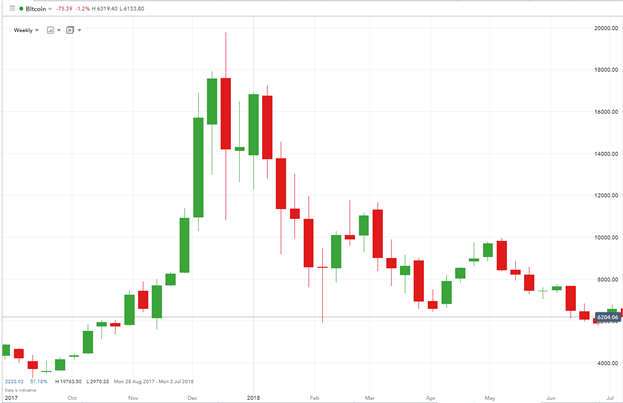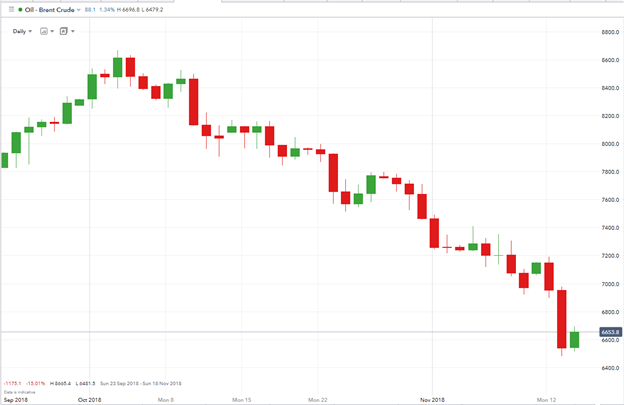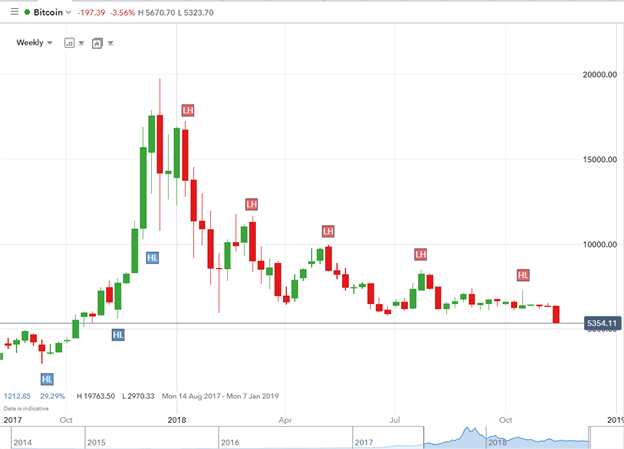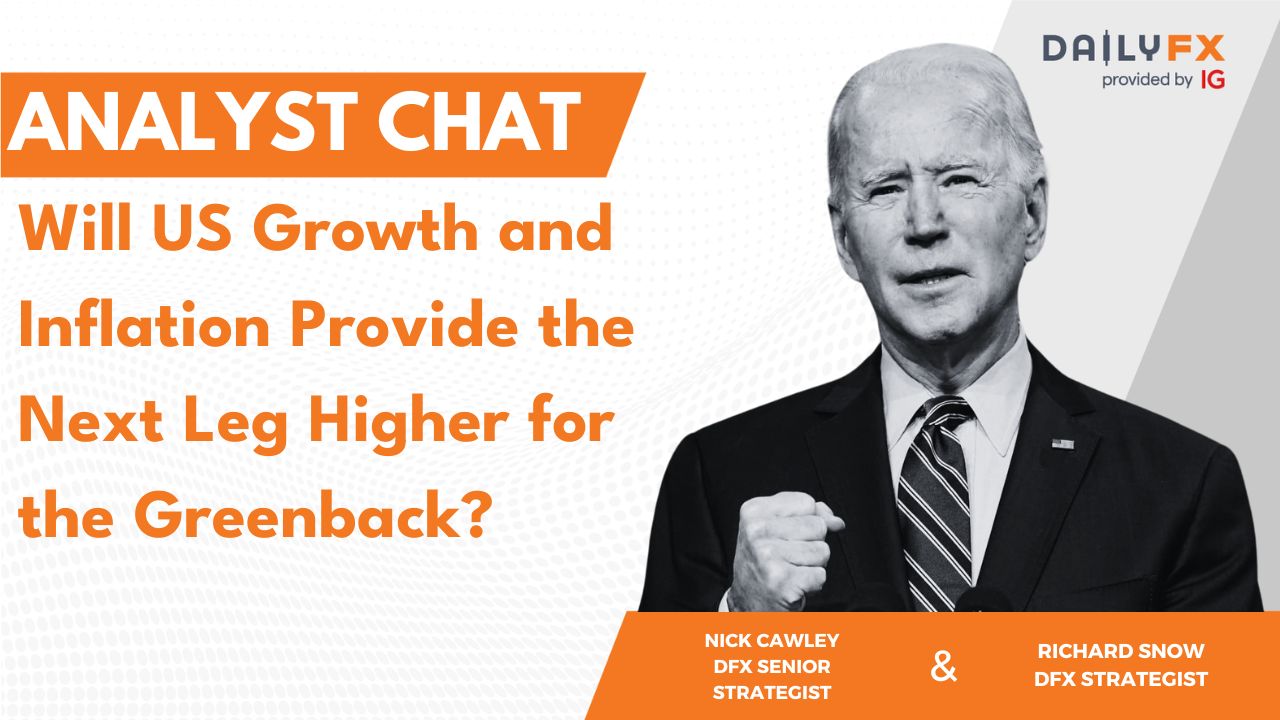Trading a market with a short position for a bearish view is realistically the same as trading with a long position on a bullish outlook, but traders can sometimes struggle with the psychological hurdle of ‘selling something I don’t have’. This counter-intuitive psychology, unless understood and overcome, can prevent traders from making a profitable trade in one of the most common environments for any financial asset. Further, beyond the mere frequency for which markets move lower, they usually move at greater speed. We will explain how the difference between investing and trading may cause confusion and, sub-consciously, prevent you from successfully trading in a bear market.

What is a Bear Market?
There are many definitions of a bear market but one of the most commonly accepted is a market that has fallen 20% from its high over a period of time, normally two months or more. This compares to a market correction which is generally defined as a market that has fallen around 10% in under two months. Bear markets are characterized by low investor confidence and fears of further falls. As the market moves lower, selling pressure increases causing sharper falls as buyers retreat from the market and price action continues to move lower until selling dries up with buyers reappearing as confidence returns.
Bear markets are also characterized by sharp sell-offs which tend to be more readily identifiable on the charts. Large red candles indicate a market where sellers are totally dominant and progress holds through an extended timeframe while covering significant ground, pushing prices through stop-losses* set below critical support levels. In these markets, buyers stay out of the way, allowing prices to fall even further.
*Stop-Loss - - A price set by a trader to automatically close his/her position to prevent potentially larger losses.
The bottom of a market correction may be easier to identify – using technical analysis for example – than the bottom of a bear market which is clouded by persistent negative sentiment.
Bitcoin (BTC) Bear Market 2017-2018 – Down 69% in Seven Months

Oil Bear Market 2018 – Down 25% in 36 Days

Some of the World’s Best Traders are Bear Traders
Financial market history is littered with examples of experienced bear traders making out-sized returns selling markets short. Paul Tudor Jones is reported to have made over USD100 million shorting the US equity market just ahead of the October 1987 crash. In the aftermath of the crash, Bankers Trust trader Andy Krieger is said to have made around USD300 million short-selling the New Zealand dollar. And the numbers get larger with Jim Chanos pocketing a reported USD500 million from short-selling Enron in late-2000. George Soros famously made USD1 billion betting against Sterling in 1992, while John Paulson is rumored to have personally made USD4 billion shorting the US subprime mortgage market in 2007.
Further reading: A History of Major Financial Bubbles, Crises and Flash-Crashes

Trading Psychology for a Bear Market
This is an area that some traders find difficult although - as we will show - taking a long or a short position is generally the same potential risk. The main psychological drivers or emotions – fear, hope, greed, despair for example – are the same for trading the market from a short- or long-position. To trade successfully you need to make a clear, unbiased, emotionally-detached and fully qualified decision.
Many people may have invested in financial markets before – going long – and are comfortable with this stance. Investors may look at a position over a longer time frame and if the position becomes loss-making they feel that by owning something this move will eventually be reversed. On the other hand, to trade a market from both a long and a short position, traders must maintain an emotional detachment towards their position, which typically leads to trading in shorter time-frames. Retail traders should fully understand the difference between trading and investing and decide which they want to do before they enter the market.
How to Build Confidence in Trading
People who have not traded a short position before may feel that it is ‘unethical’ as they are betting that the price of a stock, currency or commodity is going to fall – they are a value destroyer. On the other hand, if they trade from a long position, they are betting that the value of their asset class is going to rise – they are a valuecreator. Their confidence may suffer but neither is true. Successful traders make a rational decision to try and benefit from where they buy an asset and where they sell it. It does not matter if you sell the asset first before buying it back or vice versa – you are looking to benefit between the two prices you have traded at.
Traders should also understand that their actions are not taken with the aim to affect price moves; they are just looking to benefit from these moves. Traders who have a short position may also have a fear – unconscious or not – of being caught in a short-squeeze, a market when prices jump sharply higher. Don’t. If you have kept your discipline – see below – you have little to fear from a short-squeeze.

How to Identify a Bear Market – Tips and Signals
We mentioned earlier that trying to identify when a bear market is approaching is difficult as sometimes the turn from a bullish/neutral market set-up to a bear market can be quick. We can use technical analysis however to evaluate the market from which we can attempt to identify signals and reversal signs. Examples would include:
A Few Rules and Tips for Short Sellers
- Fundamental analysis is the same for both bull and bear traders. Reasons for being bullish or bearish on an asset class should be clear to you.
- Technical analysis does not change if a market moves up or down.
- Trade set-ups, stop-losses, margins, discipline, leverage are the same and they are essential to understand and use correctly and consistently.
- Run profits and cut losses.
For more information, read our guide to creating a trading plan, or tune into our podcast on
Successful Bear Market Trading and Strategies and Techniques.
Trading a Long/Short Foreign Exchange Position
It is possible to be both bullish and bearish in the same trade; indeed, it is commonplace in the foreign exchange market. A trader should look at a range of currencies and decide which is the strongestcurrency and which is the weakest currency. For example, if the US Dollar was the strongest currency and the Japanese Yen the weakest, a trader would go long USD/JPY. The trader now effectively has two positions at the same: a long US Dollar position and a short Japanese Yen position. So, anyone who has traded a foreign exchange currency pair is already a short seller.

Bear Market Strategies for Other Asset Classes
Other asset classes that qualify for short selling include, but are not limited to:
- Equities or stocks – quoted companies from around the world that are traded on regulated exchanges.
- Indices – these include the S&P 500, Nasdaq 100, FTSE 100 and the Dax 30.
- Commodities – these include gold, silver, copper, Brent crude oil and US crude oil.
- Cryptocurrencies – these include Bitcoin, Ethereum, Ripple and Litecoin.
When trading these asset classes, you are making a prediction on them either going up or down, nothing else. Traders looking to go long of these asset classes will try to identify a market with a ‘trend’ and apply fundamental and technical analysis to plan where to buy and then where to sell. For example, traders looking to buy the market would look for an ‘upward trend’ and buy ‘higher lows’ on the candlestick chart to benefit from rising prices. Traders who are looking to sell the market would look for a ‘downward trend’ and plan where to sell and then buy back. In this example, traders would look to sell ‘lower highs’ to benefit from falling prices.

Further reading: Buy the Higher Low and Sell the Lower High
Bear Market Trading: A Conclusion
Trading is trading, and it does not matter if you open a long- or a short-position as the fundamental understanding and technical analysis are the same for both. Circumstances change little even if psychology may. Where newer traders may find difficulty is the understanding that you can sell something that you don’t already own in financial markets and buy it back later as easily and profitably as buying something before you sell it. There should be no ‘block’ or stigma to stop you ‘short-selling’ although you must feel fully comfortably and confident before you make any such trades. Trading is about trying to profit between two different price levels, but it shouldn’t matter in which order you do it.







